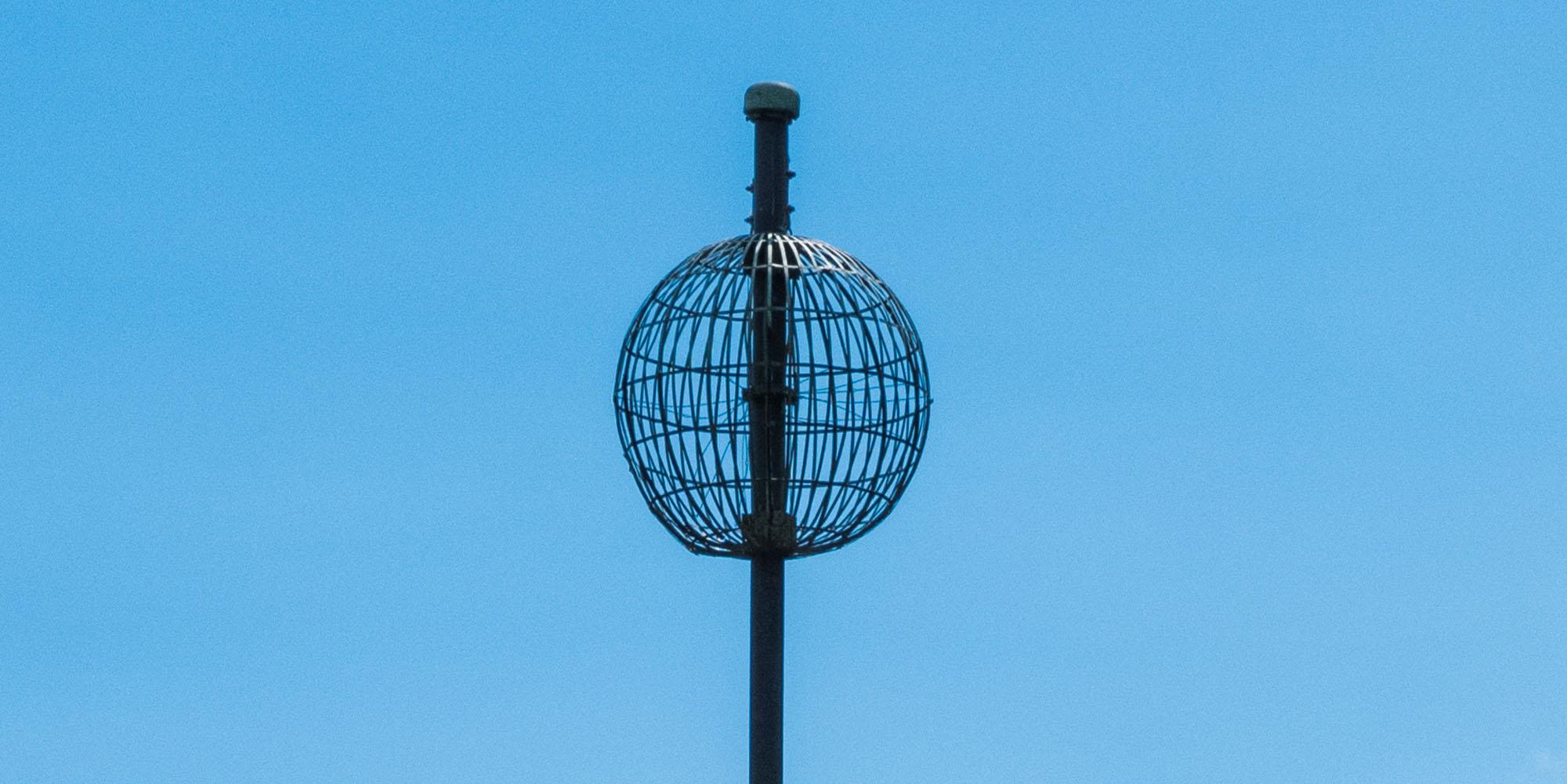Navigational devices, time-keeping instruments, or monuments to modernity?
A Collections Chronicles Blog
By Martina Caruso, Director of Collections and Exhibitions
October 31, 2024
Timekeeping has been integral to Western seafaring for centuries. Knowing the correct time enabled sailors to determine their longitude, which was central to efficient and safe navigation. But even with the existence of marine chronometers—invented in 1773 by John Harrison (1693–1776)—there were critical issues. Since chronometers varied in their going-rate (how fast or slow they ran from day to day), captains were responsible for rating (or calibrating) their timepieces when in port, allowing them to make any necessary corrections, and chart their course with certitude while at sea.
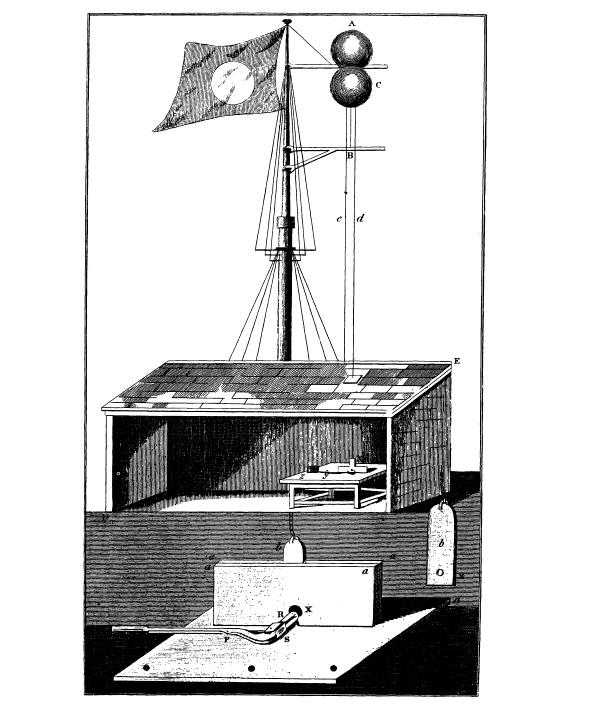
In the 18th and 19th centuries, the most common methods of publicly disseminating the correct time included firing guns, on the presumption that both the sound report and/or the gun smoke would alert interested parties of the time.
Luckily, in 1829, Royal Navy Captain Robert Wauchope (1788–1862) conceptualized and put in action a revolutionary experiment in Portsmouth, England: a time ball mechanism. Wauchope’s design consisted of installing two large balls on a flagpole, placed close to the water’s edge. One ball was fixed at the top of the pole, while the other was weighted and mobile. Minutes before noon, the second ball was raised up the flagpole until it met the stationary ball, so that no light passed between them. A flag was flown nearby, to warn observers of the imminent drop, which Wauchope estimated took a little less than half a second. When captains saw light between the balls, they checked their chronometers against the official time and made corrections if needed.
Engraving of Captain Robert Wauchope’s design for the time ball at Portsmouth from Edinburgh new philosophical journal, viii (1830) 290. From The First Time-Balls by I. R. Bartky, and S. J. Dick. Journal for the History of Astronomy, Vol. 12, P. 155, 1981.
A year later, Wauchope proudly claimed, “There will be no port of any consequence into which a ship can enter, where an accurate rate for the time-pieces on board may not be found.” He gathered support from London’s ship captains, and in 1833, the Royal Observatory in Greenwich erected its own time ball that is still active today.[1] This 1950s video from the archives of British Pathé show how the Time Ball on top of Greenwich Observatory is wound and dropped to signal 1 o’clock.
Soon after, time balls began appearing in ports worldwide, from the Cape of Good Hope and Jakarta to Valparaiso, Mauritius, and New Zealand. By 1845, there were a dozen time balls installed globally to aid ship captains and navigators in the crucial task of rating their chronometers and facilitating accurate navigation.
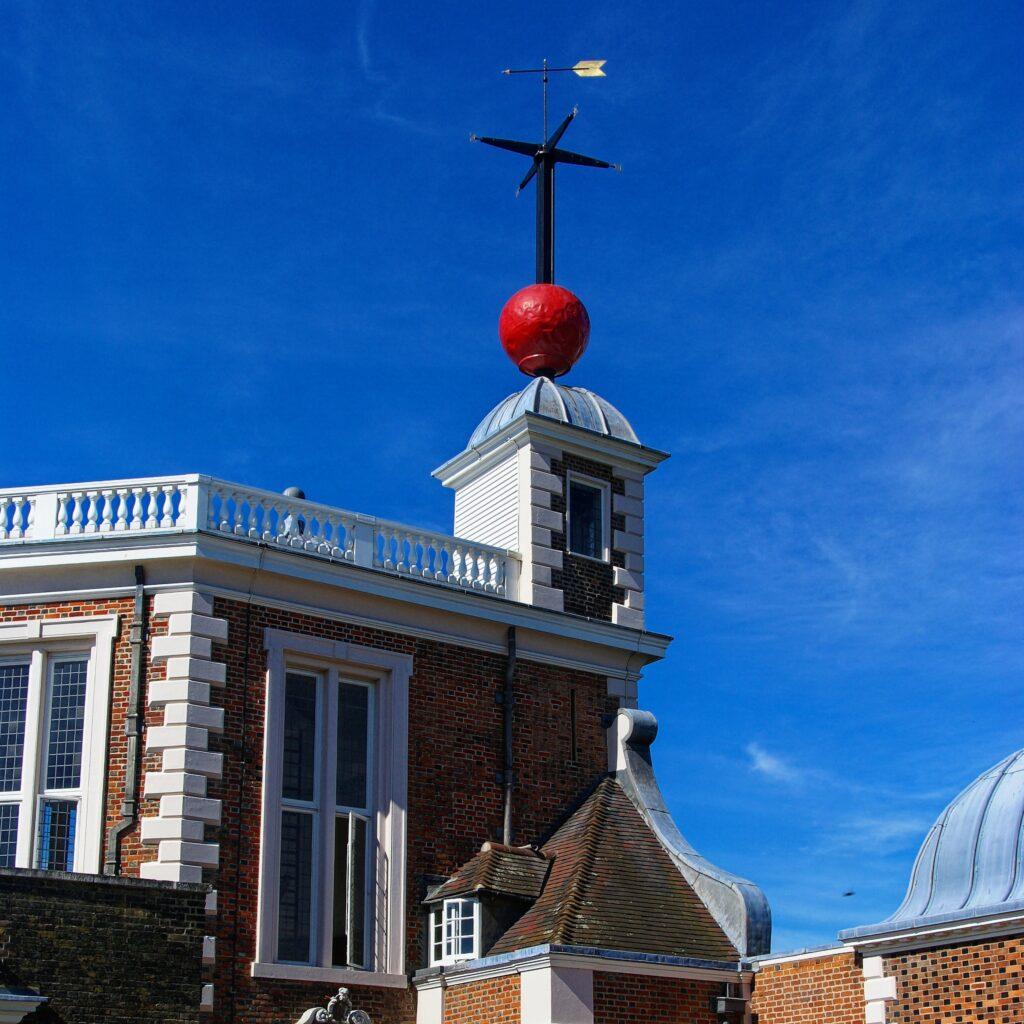
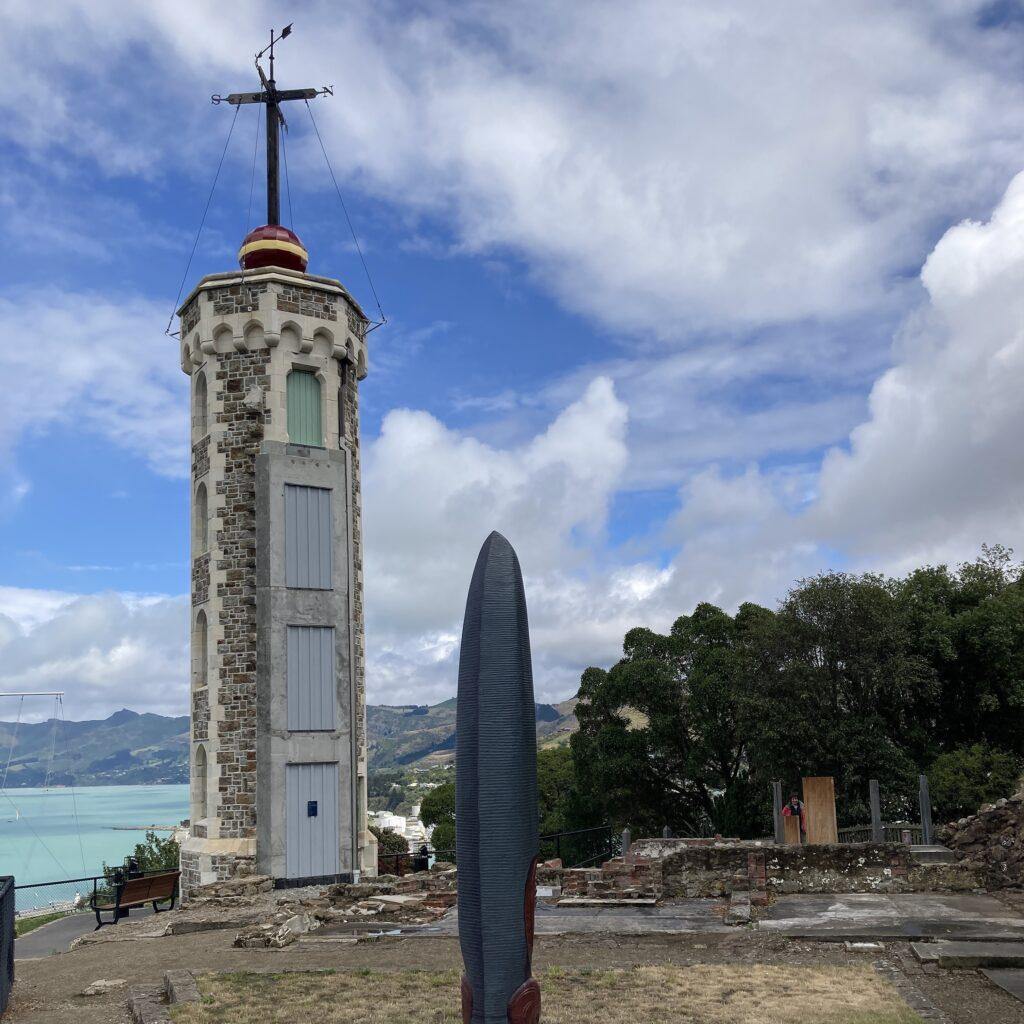
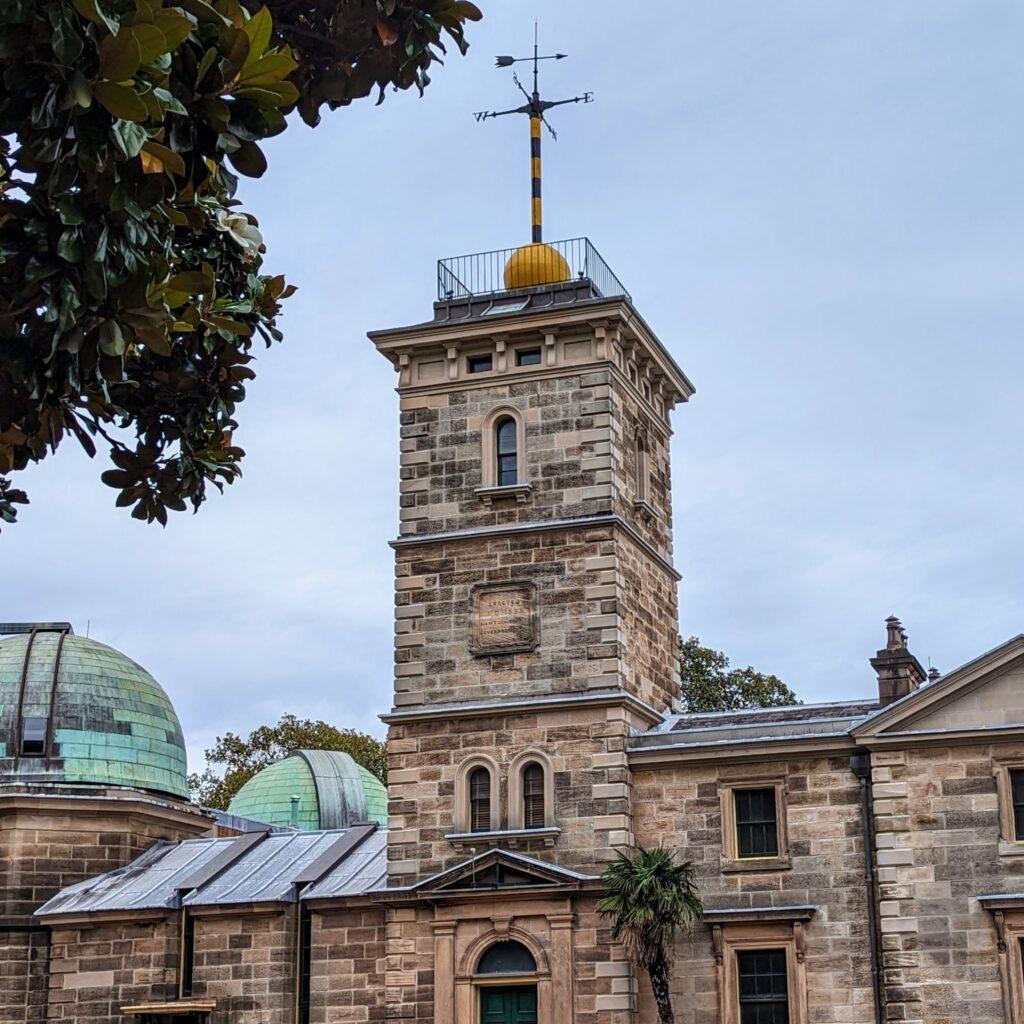
Left: Time Ball at the Royal Observatory in Greenwich, London.
Center: Lyttelton Tower and Time Ball, in Lyttelton, New Zealand.
Right: View of the Sydney Observation, on Observatory Hill, with time ball in lowered position atop the observatory.
In the United States, major cities, both coastal and inland, quickly followed England’s lead. In the decades after the American Civil War, time balls joined the array of newly erected monuments across the country, embodying the cultural, commercial, or political aspirations of Americans. These globes were typically placed atop the highest point in the center of a city, such as tall buildings, towers, and steeples. They were made of a metal skeleton and covered in canvas or leather of various colors, and an electric pulse sent by the Naval Observatory in Washington, DC, caused them to drop at noon.
Though largely accurate, time balls were subject to errors caused by weather or other issues. Their failures to drop were noticed and published in city papers, like in this excerpt from The Kansas City Electric Time Ball:
“For the year ending Nov 1st, 1880, the ball was dropped exactly at noon on 355 days; on four other days at five minutes past noon…on four other days it was not dropped, leaving only three cases of inaccuracy of dropping.”[2] The Kansas City Electric Time Ball by H.S. Pritchett, 1881, p. 210.
In the 1880s and 1890s, time balls proliferated throughout the country as devices designed to disseminate time, under the sponsorship of the United States Navy. The number of time signals had become so large that the Navy’s Hydrographic Office[3]“The one activity of the Navy Department which, as a matter of daily routine, assists the Navy and commerce at the same time, is the Hydrographic Office. The military mission of this office is … Continue reading prepared and issued official lists that explained the nuances and details needed to interpret what was seen at sea and port. This included types (such as balls, guns, flags, and disks), local time used, preliminary signal, and estimated accuracy; some entries were dismissed with the phrase “not suitable for rating chronometers.”
With the turn of the 20th century, new commercial technologies—such as those of the Self-Winding Clock Company, in Brooklyn, NY—eliminated the need for mariners to recalibrate their chronometers, and therefore the need for public time signals. On land, however, time balls found a new audience. This era of the increased popularity of time balls, between 1880s and 1920s, coincides with the emergence of the historical period called “modernity” and the rise of the artistic movement now known as “modernism.” Due to this specific time frame, many historians now tend to identify time balls as symbols of civic modernity, arguing that their fame grew out of their ability to indicate modern times, rather than the correct time.[4]As modernity and modernism took shape, contemporaries identified the strong sense of contingency that permeated European and North American cities; the “vast agglomerations of people in widely … Continue reading
In spite of their early popularity, during World War I, the Hydrographic Office dismantled most of its time balls, and by 1922 only a few remained in service. The decline went hand-in-hand with the advent of radio transmissions.
Today, a few time balls remain operational in England and New Zealand, while others are flagged as “on stand-by” or “on exhibit/display,” including the ones now on display at the San Francisco Maritime National Historic Park[5]San Francisco’s first time ball was dropping from the top of the signal-pole located on Telegraph Hill, a spot visible to vessels anchored throughout the San Francisco Bay. In 1898 the time … Continue reading and the South Street Seaport Museum.
New York’s Time Ball
Many connect the history of time balls with the annual New Year’s Eve ball drop in New York. The tradition of dropping a ball in Times Square began more than a century ago when Adolph S. Ochs (1858–1935), the publisher of The New York Times, hired the Arkraft Strauss Sign Corporation[6]The Arkraft Strauss Sign Corporation was New York City’s preeminent sign designer and manufacturer in the 20th century, responsible for creating some of the great icons in American advertising. … Continue reading to build and then lower a 700-pound wood-and-iron ball, five feet in diameter, and illuminated by 100 25-watt bulbs, to mark the passage from 1907 to 1908.[7]The Times moved in 1913, but the Times Square ball drop continued, interrupted only by wartime blackouts in 1942 and 1943. Today, the drop is initiated by a laser-cooled atomic clock in Colorado, the … Continue reading
But New Yorkers first got their own real time ball before that, in September of 1877, when Western Union employee George May Phelps (1820–1888) designed and built a ball, made of semicircular sheets of copper, to be installed on the top of the Western Union Building at 195 Broadway.
The 10-story building was the first Manhattan’s “skyscraper” —although that term was not used in print until the 1880s— designed by George B. Post (1837–1913), who in the following decades would become one of New York’s most prolific architects of tall buildings.[8]George B. Post was an architect trained in the Beaux-Arts tradition, who designed, among others, the old New York Times building (1889) at Printing House Square, Bronx Borough Hall (1897), and the … Continue reading At the time, the Western Union Building was the tallest building in the City, allowing people passing by to easily see the time ball and adjust their watches.
As was the case with most time balls, the staff of the Western Union Building oversaw the hoisting of the time ball from five to two minutes before the hour, after which a signal from the Naval Observatory in Washington DC would drop the ball precisely at noon.
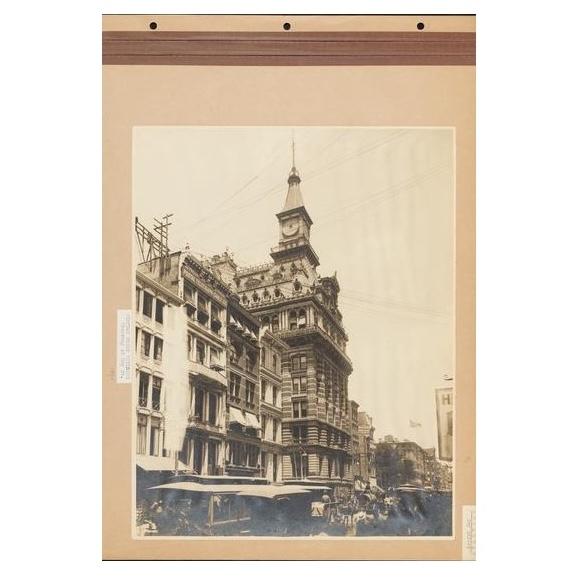
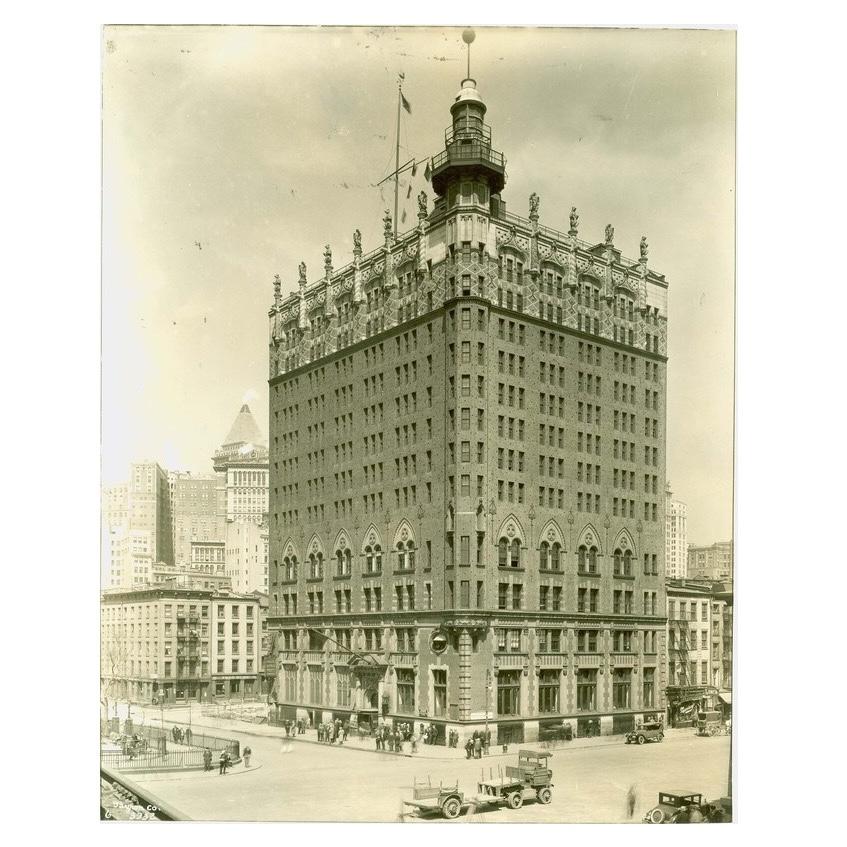
Left: Western Union Building, Broadway at Dey Street, ca. 1890. J. Clarence Davies Street Views Scrapbook. Museum of the City of New York X2012.61.4.65
Right: Seamen’s Church Institute Headquarters at 25 South Street and Coenties Slip. ca. 1913. Seamen’s Church Institute Archive.
In 1914, the Western Union Building was demolished along with its time ball. Auspiciously, the year before, in 1913, a new time ball was placed atop the nearby Seamen’s Church Institute (SCI) building at the corner of 25 South Street and Coenties Slip, as part of the Titanic Memorial Tower. The Hydrographic Office observed that “a visible noon time signal is thought to be desirable solely for the sentimental reason that this great port should not be without one.” They explained that at the time “observatory time clocks are to be found in nearly every office in this City; that wireless noon signals can be used by almost every steamer; that nautical firms not only take charge of and rate chronometers, but also when requested send Agents to ships to correct chronometers.” They added that “the most conspicuous and best known location in the City,” the Metropolitan Life Tower, had a “thoroughly admiral night signal” so the SCI was a good poetic alternative.
A SCI press release mentioned that the mechanism was put into operation on November 1, 1913 on top of the Titanic Memorial Tower and that the 200-lb ball consisted of “a bronze frame, four feet across, covered with canvas that has been painted black for maximum visibility. [It was] mounted on a rod 15’ 10 ½” in height that pierces the center of the ball and contains hosting cables.”
The Titanic Memorial Tower with its time ball remained at 25 South Street until 1968, when, after 55 years of service, SCI moved its headquarters to 15 State Street. The old building, along with the tower on top, was set to be demolished. A group of concerned preservationists led by Frederick Fried (1908–1994), Friends of South Street Seaport, and the South Street Seaport Museum, unite together to persuade the demolition company to donate the structure, with its time ball –now recognized as the Titanic Memorial Lighthouse– to the South Street Seaport Museum. In a letter to the company, Museum founding president Peter Stanford (1927–2016) wrote the following:
“The Lighthouse atop the building was dedicated many years ago, when new, to the victims of the Titanic disaster. We believe this monument should not be doomed as part of the obsolete building to which it happens to be attached. The tragedy of the Titanic, and its lessons to history, are not less real today than in 1912…It would dishonor the memory of the victims by destroying the monument within the lifetimes of those who remember.”
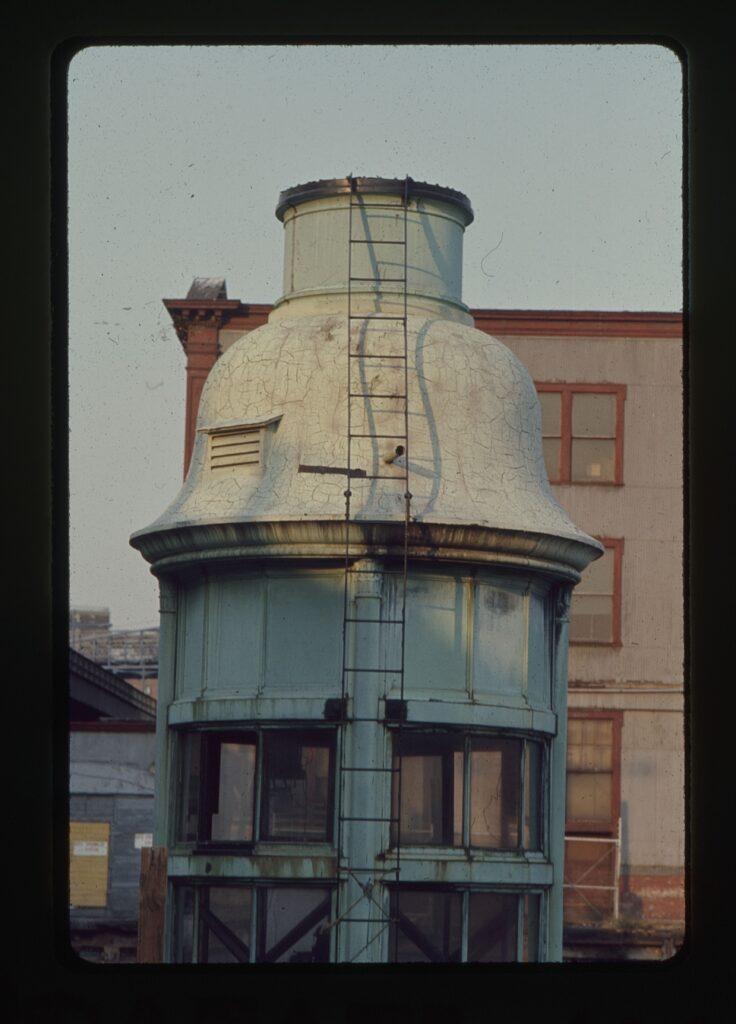
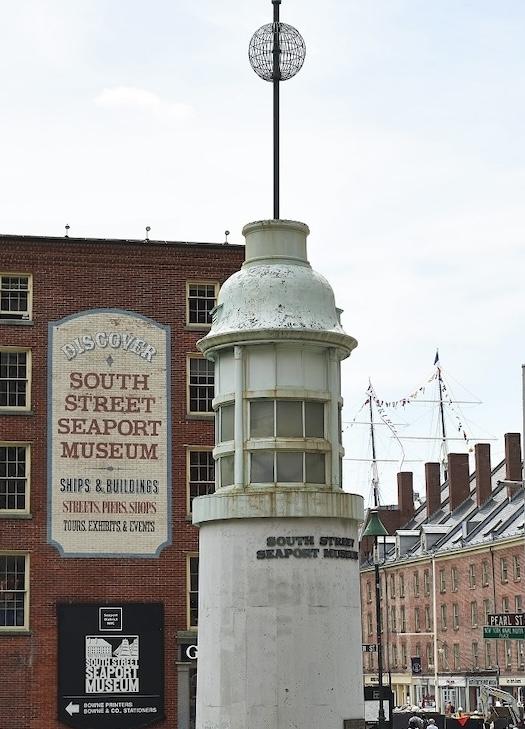
Left: South Street Seaport Museum Photo Archive, Slide Collection, 1968-1969.
Right: James Keivom, 2017.
The structure with a small array of additional mechanisms and components was delivered to the Seaport Museum on July 25, 1968 and was formally accessioned as part of the Museum’s permanent collection in 1975. It was placed on top of a modern concrete podium, in the small park where it is still located today, at the intersection of Fulton and Water Streets, marking the entrance of the South Street Seaport Historic Seaport District and providing a space for people to stop and reflect on the tragedy and its impact on Lower Manhattan over one hundred years ago.
Titanic Memorial Lighthouse Restoration Updates
In 2023, the Museum selected renowned preservation architects Jan Hird Pokorny Associates, Inc. from a highly competitive field to design a light-touch approach to the memorial’s restoration that prioritized the stabilization of the artifact, followed by aesthetic improvements and restoration of the light and time ball.
I recently met with Kurt Hirschberg, Associate Partner from Jan Hird Pokorny Associates, to talk about the plans for restoring and re-activating the time ball on top of the structure. Below is a transcript of this conversation, the second in a series focused on the Titanic Memorial Lighthouse restoration. Revist the first blog post in the series at Shining a Light on a Unique Public Artifact.
Martina Caruso (MC): Let’s talk about the time ball on top of the Titanic Memorial Lighthouse. Is the structure on view at the Seaport Museum today original to the 1913 construction?
Kurt Hirschberg (KH): The time ball structure on top of the memorial is not original to 1913; it is dated to ca. 1932. The original ball would have been fabricated out of bronze rods welded together. It was then wrapped with nine-inch wide strips of canvas sewn together—almost like how they would construct a football—and then it was painted with some type of tar. This photograph (in the center) from the SCI Archive shows somebody going up on the roof with the can of goop and the giant paintbrush to re-coat the time ball.
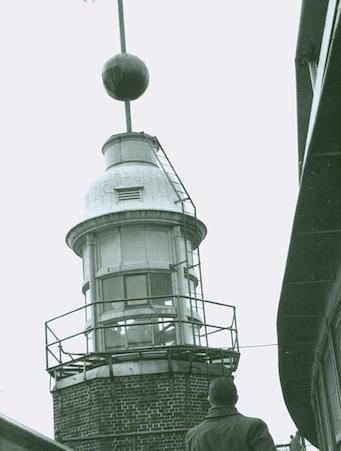
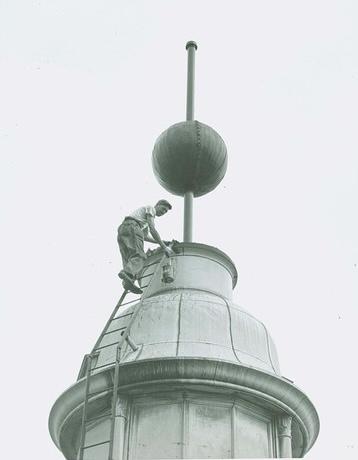
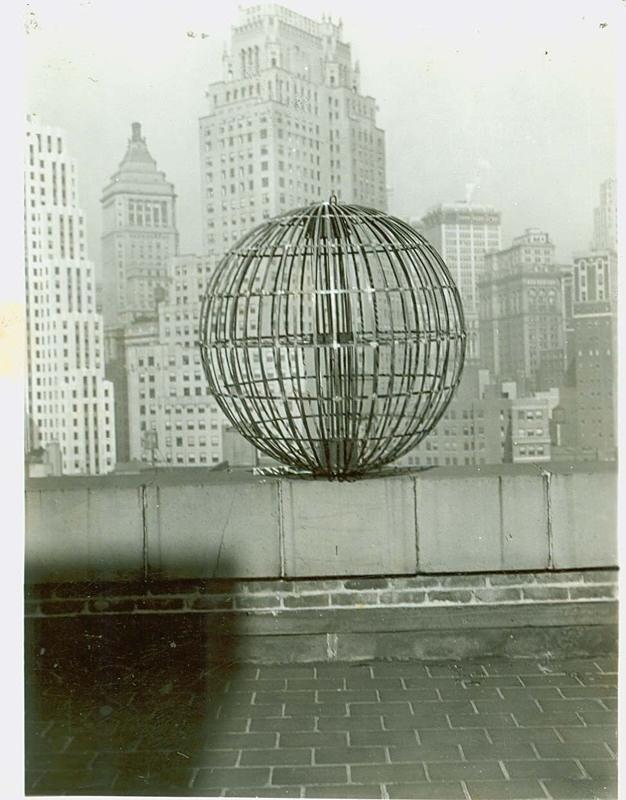
Seamen’s Church Institute, ca. 1913-1930s
We know that the ball mechanism started to fail around 1932. Records mention that when SCI technicians had gone up to do the annual maintenance, they found several of the ribs were broken, so they fabricated a whole new ball, but this time made of steel strips, riveted together. They opted to not go back to a welded structure because over time the welded structure sagged, modifying its shape. The time ball that is currently on top of the memorial is this second one.
MC: How did it function? Its connection with the Navy National Observatory in Washington DC is really fascinating.
KH: The time ball mechanism was fully switched through the Western Union Telegraph. The tower itself has a Western Union clock, still there today, which would have been the triggering ball-dropping mechanism. Every day, at 11:45 am, the tower would receive a telegraph signal from Washington, DC, that would activate the motor to hoist it up. When it reached the top, it had an electromagnetic magnet that would hold the ball in place. Then, at approximately 11:59 am, the tower would get another telegraph signal that would release that electromagnet and start the process of lowering the ball. It took approximately 60 seconds to move from the top down.
What’s interesting is that the ball was only motorized in one direction. The motor only pulled it up and the magnet held it. It was an enlarged regulator mechanism similar to what one found either in a cuckoo clock or in a music box, regulating the speed of the musical performance.
MC: Do we know when the time ball stopped working?
KH: Based on research in the SCI Archive, I believe the time ball stopped working at some point in the early 1960s. The SCI knew they were going to relocate to a new building, and they basically just said, “Forget it,” and they let it go. But it did run at least once after 1967, on April 11, 1986 when the Museum did a re-dedication of the structure, and the time ball came down at noon, but we do not know how they managed to make it happen. It appears that there was a temporary hoist mechanism used for this one-time operation. The temporary hoist is still in place today, secured to the steel framing above the interior deck.
MC: Did you find any additional interesting bits of history connected to the time ball?
KH: Well, one of the most interesting things that I found in the SCI Archive is notes about the time ball being frozen in place. In the 1920s the ball became frozen to the mast in an ice storm for several days before it would thaw out enough to become free from the receiver at the top of the roof. The storm also froze the receiver, and it took about a week for it to thaw enough, and after that, whenever the conditions were such that there was a threat of freezing, SCI would only lower it halfway into the receiver so it would never get stuck again.
MC: Can you talk a little bit about the condition and thoughts behind the current restoration plan?
KH: Unfortunately, because the original ball was replaced in 1932 with a design that wasn’t as strong as what was done originally, it makes a lot more sense to actually go back to the drawing board, and design something that’s going to last a good amount of time.
For example, the existing system had one single cable. So if that cable were to fail, if something were to get jammed, if it got slightly displaced on the mast, you could have a lot of problems. So what we’ve done is design a double pulley system in the mast. Secondary cables ensure that things are going up and down nice and uniform, and we won’t run the risk of that time ball potentially shifting.
Another challenge was to figure out the best means to get the ball to start, stop, and release without a Western Union Telegraph signal. So, one of the things we looked at is utilizing something similar to the mechanism used today in magnetic door sensors that work for alarm systems. These mechanisms know when a door is open and closed, and it could be applied to our needs. It could also be very discreetly placed inside the upper part of the tower so one won’t be able to see it. A very simple solution, building off of the original concept of using an electromagnetic device.
MC: Using the technology of 1913 and integrating the technology of 2024 is a great idea. Let’s talk about the actual ball; what are your thoughts on the preservation and maintenance of a canvas or leather covered ball?
KH: There’s a good deal of documentation in the SCI Archives about the regular maintenance that the earlier canvas ball required, and the fact that it just really wasn’t performing right. The leather probably came around 1932 when they rebuilt the structure, and it was a logical upgrade, since this material was less flexible than canvas and gave the opportunity to sew larger pieces.
What we want to keep and mimic is the aesthetic of the ball and its texture. It is something that when you observe more attentively you could see, so we spent a good deal of time looking at how we could recreate that look and feel faithfully, but in a material that wouldn’t require somebody going up on the roof and addressing it on an annual basis. The idea we came up with is casting it out of fiberglass around the framework, capturing the texture of the leather right in the fiberglass. We will make a new framework replicating the current one, while the historic one will be removed and become a separate artifact related to the structure for the Museum’s collection. Lastly, at the end of the day, it’s also going to be lighter than the older, coated canvas or leather.
MC: I did some research, and it appears that the few time balls functioning today have various durations related to the ball’s drop. Some descend quickly, while others drop more slowly, in a longer theatrical style. Do we know how long it would have taken for the Titanic Memorial time ball to drop?
KH: This is another interesting aspect of the restoration. The opportunity we face with regards to the time ball timing is that 100 years ago people would be willing to watch something go up, and 15 minutes later come back down, but today the attention span of the average person is no longer such that that timing is acceptable. So we will keep testing the most optimal timing to be able to balance and retain some of the historical theatrical performance aspect of it, with the average passerby’s attention span.
MC: Let’s take a closer look at another time ball mechanism still in existence today. How many did you find in your research that are still functioning? Was there a structure that you found particularly inspiring?
KH: There are very few operational time balls. Only a few still drop in cities across the world daily, mostly for tourists during special occasions, not navigators. These mechanisms remain some of the most spectacular reminders of an almost forgotten tradition. Their systems required a lot of maintenance, periodic calibration, and all that went obsolete with a radio signal. But, there’s something wonderful about them, because they are a reminder of the days of a city like New York that, even then, was known to be a fast-paced city, where people would stop for 15 minutes to set their watch, and there’s something very wonderful and romantic about that notion.
MC: I look forward to showing more of the restoration work soon underway on future blog entries, which may focus on the memorial’s lights, and its wrought iron gallery and gantry, as the process unfolds. If you haven’t read it already, be sure to read the first blog post in the series, Shining a Light on a Unique Public Artifact. The South Street Seaport Museum particularly invites the descendants of Titanic passengers and crew to sign up here for updates on this project.
Additional Reading and Resources
The Time Ball from the “Illustrated London Almanack”, Anonymous, 1844. The Royal Observatory Greenwich.
The First Time-Balls by I. R. Bartky, and S. J. Dick. Journal for the History of Astronomy, Vol. 12, 1981.
The Bygone Era of Time Balls by Ian R. Bartky, published in Sky & Telescope, January 1987. South Street Seaport Museum Archive.
A Brief History of Time Balls by Scott Huler. The New York Times, December 30, 2004.
A Ball of a Time: A History of the New Year’s Eve Ball Drop by Latif Nasser. The New Yorker, December 23, 2013.
The Surprising Origins of the New Year’s Eve Ball Drop Tradition by Olivia B. Wasman. Time Magazine, December 30, 2016.
Time balls: The rise and fall of a timekeeping icon, BBC, September 19, 2021.
The Deal Time Ball (1864-1927) by Graham Dolan, 2014-2024. The Royal Observatory Greenwich.
Time Balls: Marking Modem Times in Urban America, 1877-1922 by Alexis McCrossen. Southern Methodist University in Dallas, Texas.
References
| ↑1 | This 1950s video from the archives of British Pathé show how the Time Ball on top of Greenwich Observatory is wound and dropped to signal 1 o’clock. |
|---|---|
| ↑2 | The Kansas City Electric Time Ball by H.S. Pritchett, 1881, p. 210. |
| ↑3 | “The one activity of the Navy Department which, as a matter of daily routine, assists the Navy and commerce at the same time, is the Hydrographic Office. The military mission of this office is to supply ships of the Navy with charts, sailing directions and all that goes with them to make possible safe navigation of all seas of the world.” United States Navy Hydrographic Office by Rear Admiral W. S. Crosley, U. S. Navy, Recently, Hydrographer, U. S. Navy. October 1927 Proceedings Vol. 53/10/296. |
| ↑4 | As modernity and modernism took shape, contemporaries identified the strong sense of contingency that permeated European and North American cities; the “vast agglomerations of people in widely contrasted roles and situations” made cities into “places of friction, change and new consciousness.” Time balls at once reflected and reinforced this new consciousness. Dropping only once a day, and otherwise standing as mute symbols of the time, they monumentalized the now, the present, the instant.” The Cities of Modernism by Malcolm Bradbury, in Modernism, 1890-1930, p. 98. See also Chicago and New York: Two Versions of American Modernism by Eric Homberger, in Modernism, 1890-1930, pp. 151-161. |
| ↑5 | San Francisco’s first time ball was dropping from the top of the signal-pole located on Telegraph Hill, a spot visible to vessels anchored throughout the San Francisco Bay. In 1898 the time ball moved to the top of the Ferry Building where it remained until 1907. Late in April 1909, newspapers reported a “newer, more glinty and faster falling ball will announce the noon hour from the highest point [415 feet above sea level] on the Fairmont Hotel [where] it is … visible over a greater range than the one on the ferry tower and will be of more value … to the shipping in the port.” On June 30, 1937, the time ball dropped for the last time as technology rendered it obsolete. Late in 1953 when the roof of the Fairmont was refurbished, the time ball was rediscovered and six months later it was donated to the Maritime Museum. Today, the time ball is in the San Francisco Maritime Museum National Historic Park’s “The Waterfront” exhibit in the Visitor Center. |
| ↑6 | The Arkraft Strauss Sign Corporation was New York City’s preeminent sign designer and manufacturer in the 20th century, responsible for creating some of the great icons in American advertising. Particularly known for their “spectaculars”—giant illuminated signs often incorporating special effects and moving parts—Artkraft Strauss’ most famous works include the “smoking” Camel Cigarettes sign, the “flying” Anheuser-Busch eagle, and the Coca-Cola sign at 2 Times Square. The company was also responsible for the New Year’s Eve ball drop in Times Square, a tradition they began in 1907, until 1996. The Artkraft Strauss records are hold by the Manuscripts and Archives Division at The New York Public Library. |
| ↑7 | The Times moved in 1913, but the Times Square ball drop continued, interrupted only by wartime blackouts in 1942 and 1943. Today, the drop is initiated by a laser-cooled atomic clock in Colorado, the primary time standard for the United States. It continues to be our most spectacular display of public time-keeping. Lots of Sparkle for a Swift Fall by Alan Feuer, The New York Times, Dec. 24, 2009. |
| ↑8 | George B. Post was an architect trained in the Beaux-Arts tradition, who designed, among others, the old New York Times building (1889) at Printing House Square, Bronx Borough Hall (1897), and the New York Stock Exchange (1904). One of the most Interesting structures in the South Street Seaport Historic District is a Romanesque Revival building designed by Post, for Ellen S. Auchmuty, a Schermerhorn family descendent. Seaport Architectural Gems by Martina Caruso, October 1, 2020. |

